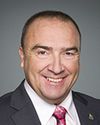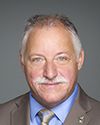I would also like to extend greetings to you and to thank the committee for giving us the opportunity to come and present the roadmap to you.
I suggest that I review the roadmap quickly. Mr. Lussier and I want to give you as much time as possible for questions. So we will give you the basics, and our answers to your questions will likely be your opportunity to get into the details in which you are most interested.
You have received the PowerPoint presentation. I will go through it very quickly. I am just going to guide you through the pages that seem to be the most important. If I may, I will start directly on page 5. I will jump over the preamble, it is there for your future reference.
I am going to talk to you about the origins of the roadmap and its content. Then I will talk quickly about the accountability measures that the roadmap has in place. I will come back to that later.
To quickly review the origin of the road map, on page 5 you have statements that we found in government budgets that gave us a bit of direction in terms of what it was intended to do.
The first time we had a statement was in 2012, which was about the same time that we were contemplating the next strategy, so it was very timely for us. We launched into consultations essentially in the summer of 2012. They took the form of a series of round tables that went around the country. We basically invited people from the community, as well as, if I can say so, the majority group, to try to get a sense of what communities thought as a whole with respect to official languages.
There were also a number of consultation elements that we paid close attention to. One was a study from this committee at the same time, which we followed very carefully. We took considerable time to review the committee's report. We also followed the sectorial consultations done by the other departments very carefully. Many of them have consultation forums with the communities, and we wanted to take stock of that insight as well.
We also organized a symposium on official languages research at about the same time, where we held discussions with our provincial colleagues.
That, broadly speaking, is what happened in 2011-2012. We gathered a lot of information. That is pretty much the exercise that we are diving back into now. We are looking for those contacts and that information in order to design a future roadmap.
Let me quickly introduce the roadmap for Canada's official languages 2013-2018.
The roadmap is built on certain major parameters. It is funded in the amount of $1.1 billion over five years. Let me remind you that the plan ends on March 31, 2018, the end of the fifth year. The strategy has 28 components or initiatives implemented by 14 federal institutions, including Canadian Heritage, which has responsibility for many of those initiatives. The 14 institutions include several other departments and crown corporations.
I would like to point out that, although the roadmap represents the key elements of what is being done in official languages, it's not all that is being done. Other departments are also active in official languages issues to different degrees and in different ways. The roadmap is also a way of presenting the key elements of what is being done in official languages and of opening windows onto the various initiatives that already exist.
The roadmap has three pillars: education, immigration and support to communities. Page 10 of our presentation shows the education pillar and the list of initiatives in education, which clearly tend to focus on youth.
The key is the assistance that the federal government provides to provinces and territories so that they can provide minority language education at primary and secondary levels. But we also assist them in post-secondary education with specific projects. Assistance is also given to provinces and territories so that they can offer second-language learning, meaning French outside Quebec and English in Quebec. That assistance comes to about $240 million per year, quite a significant amount. It comes under the education pillar.
The next pillar is support to communities. This pillar includes specific initiatives designed to support minority communities. A number of federal institutions participate in these initiatives, in particular the Department of Justice, the Department of Employment and Social Development, and the Department of Health.
I will leave it up to you to tell me the things that you would like more details about through your questions.
The final pillar is immigration. This pillar is essentially the responsibility of the Department of Immigration, Refugees and Citizenship. It has two major initiatives. One initiative deals with the reception and integration of French-speaking immigrants. We all know that it is a priority for francophone communities that immigrants settle proportionately in French across the country.
There is also training for immigrants in order to be sure that they have a solid knowledge of at least one of our two official languages. This initiative is more a matter of promoting both official languages rather than an initiative targeted to minority communities.
Page 15 shows all the pillars in one diagram. At the top of the diagram, the box describes the strategic objectives to which we are committed. I will leave it up to you to read them. If you have questions on the objectives, we can come back to them.
The last point that I wanted to cover was how we account for whatever gets done on the road map. I would submit two key sources to you. They are readily available and present the results from all of the various initiatives in the presentation.
The first one is annex 5, on page 13. It's one of the supplementary information tables that accompanies the 2013-2014 departmental performance report. It lists all of the initiatives one after the other. It provides you with the amount of funding that was forecast to be spent. It presents the amount that was actually spent. Where there's a big gap between the two, we ask that the department provide an explanation of the gap.
The last column of that table is about results, meaning exactly what has been done and what has been achieved with those investments over the year. It provides an interesting amount of information in terms of what that investment has done in a given year. If you look at all of the years successively, you're going to get an overall picture of what the road map has done or is contributing to.
The second source that we use to provide information about what the road map is doing or has done is our annual report on official languages, which is also readily available. If you'd like copies, I'd be happy to send copies to committee members. The last edition of the report was tabled, I believe, in July. It covers the year 2013-2014. We are working on the next edition, 2014-2015. The annual report includes road map achievements as well.
In it, we've blended what Canadian Heritage does in terms of its own programs with what the other departments of the road map do, so as to provide an overall view of what has been done with respect to official languages across government. A fair amount of information in that report actually pertains to what the road map has funded and supported.
Between these two sources, you have a certain amount of information about specific examples of achievements, and occasionally overall statistics in annex 5 of the departmental performance report. These are key components for us to try to communicate what's going on with the road map.




